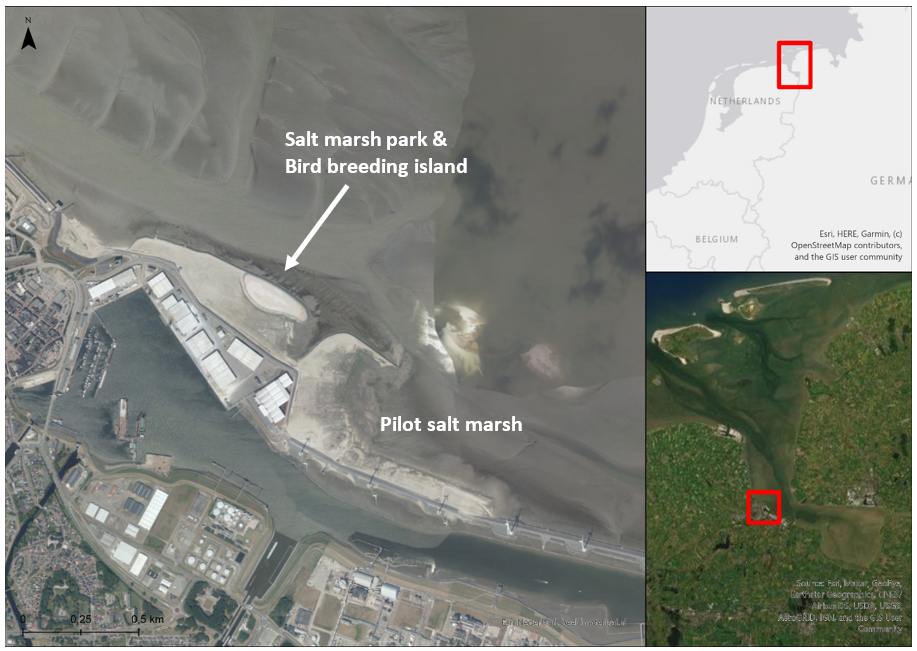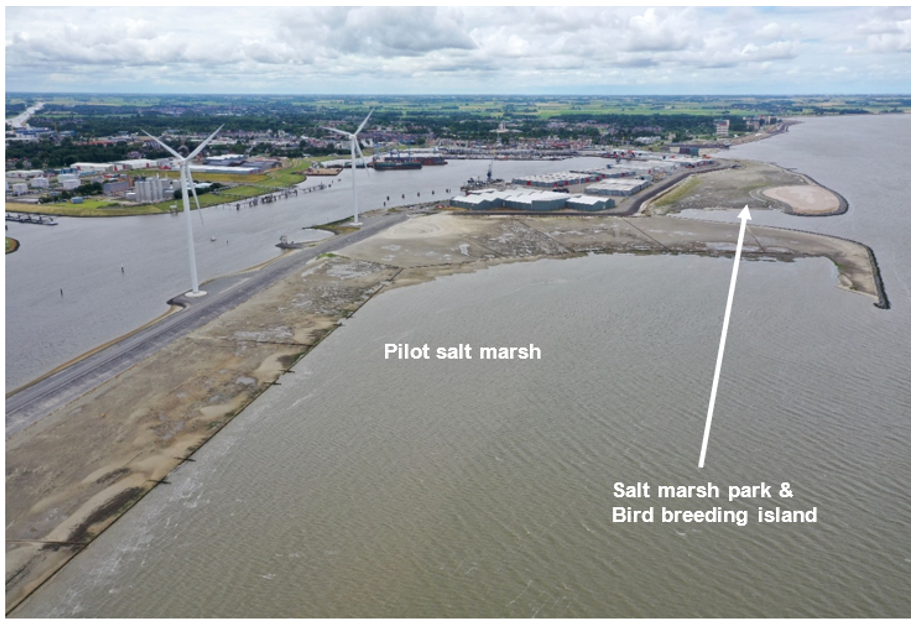Initiation
Marconi Buitendijks: connecting the city with the sea
The pilot salt marsh is located near the city of Delfzijl at the edge of the Ems-Dollard estuary. The Ems-Dollard estuary is located at the north-eastern part of The Netherlands and the north-western part of Germany and is one of the major estuaries in the Wadden Sea.
The Ems-Dollard estuary is a unique nature reserve: it is an important area for primary production and functions as a habitat for many fish, (migratory) birds and seals. The estuary is also heavily used by industry and shipping, and to a lesser extent, by fisheries and tourism. The major waterway of the estuary forms an important navigation route and there are three ports for sea-going vessels including one at Delfzijl near the project location.
The quality of life in the region is under pressure. Sea level rise and subsidence pose additional challenges to guarantee coastal safety and combine all uses of the area. On top of these challenges, Delfzijl lacked possibilities for recreation and experiencing nature. The maritime character of the port city was lost as a result of large-scale industrialization in the second half of the last century. Several dike reinforcements led to an ever-greater separation between the city and the sea.
The Marconi Buitendijks project was carried out to reconnect the city centre of Delfzijl to the Ems-Dollard nature reserve. The existing seawall was relocated and reinforced and now forms a connection between the city and the mudflats. In addition, a pioneer salt marsh was constructed along the coast, consisting of a pilot salt marsh of 15 hectares, a bird breeding island and a salt marsh park (city salt marsh) of 13 hectares.


The EcoShape salt marsh pilot
The ecological state of the Ems-Dollard estuary has been deteriorating in the last few decades. Suspended sediment concentrations are high and land-water boundaries are abrupt (no gradual transition from subtidal to intertidal to salt marsh areas). This, combined with a rising sea level and land subsidence due to gas extraction, gives reason to rethink the coastal area and provide more coastal safety while at the same time increasing the ecological value.
Salt marshes provide important natural habitats and wave protection, sequestrate carbon and mitigate effects of subsidence and sea level rise as they capture sediment from the water and can grow with sea level rise. Improving the knowledge about salt marsh construction can be used worldwide to stimulate salt marsh growth and the use of the salt marshes’ ecosystem services.
In the Netherlands there is ample experience with methods that stimulate salt marsh development for land reclamation. These consist of drained sedimentation basins delineated by permeable brushwood groynes in places where accretion already occurred. However, in the Marconi project the aim was to construct salt marshes in a location that is too low for vegetation development and has too much wave exposure for accretion of mud.
Therefore, a pilot salt marsh was constructed with three main goals:
- Create a natural land-water boundary to improve ecosystem quality;
- Develop knowledge on how to design and construct a pioneer salt marsh at a location that is not suitable yet for salt marsh development;
- Develop knowledge on the way in which design and construction affect the development of a man-made salt marsh with a focus on the following research questions:
- What is the effect of soil mud content on the morphological and biological salt marsh development?
- What effect has seeding on the rate of vegetation development in a constructed salt marsh?
Importance of the multi-stakeholder approach for initiation of the project and the design
An elaborate stakeholder process has contributed to the initiation and success of the EcoShape Marconi salt marsh pilot.
The EcoShape Marconi project is part of the Marconi Buitendijks project, which is commissioned by the municipality of Delfzijl and is a collaboration between multiple water authorities, municipalities, a province, nature organization and harbour authority. The EcoShape pilot was executed by EcoShape partners which were engineering/consultancy companies and research organisations. The pilot project including its research program was financed by the Marconi partners, EcoShape partners and Wadden Fund together. The financial contribution of multiple stakeholders was necessary for the continuation of the project.
In the design of the Marconi Buitendijks project including the salt marsh pilot, the wishes of multiple stakeholders came together. The Municipality of Delfzijl wanted to develop an interesting and attractive coastal zone for the city of Delfzijl. The municipality and water boards also had the objective of guaranteeing coastal safety. The beach and the salt marsh park matched the wishes of the municipality of Delfzijl, because both are interesting for residents and tourists. The pilot salt marsh was interesting from the point of view of research and knowledge development, but initially did not contribute directly to the main objective of the municipality. Both the salt marsh park and the pilot salt marsh had the potential to contribute to the ecological quality of the Wadden Sea and Ems-Dollard estuary. All stakeholders and partners saw and/or supported the need to deploy sustainable solutions to increase the value of the area.
The involvement of EcoShape in the project Marconi Buitendijks started in 2011 when EcoShape was asked to develop promising design variants for the coastal defense that ensured sufficient coastal safety and thereby enabled the ambitions with regard to the urban development of Delfzijl and also contributed to the ecological ambitions. In 2013, this resulted in a proposal for an ecodynamic layout of the coast near Delfzijl based on a comparison of the costs and the effects of different design variants of the coastal defense on the morphodynamics, silt balance, ecology and development possibilities of Delfzijl. The stakeholder process, at this time, included considering the wishes and requirements of the Marconi project partners. Not long afterwards, the municipality of Delfzijl commissioned EcoShape to further develop the proposed design variant so that it could be implemented.
